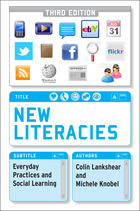Friday, January 02, 2009
Book as friend
Writing a book is always hard work, often involves plenty of frustration, but nonetheless is typically compelling work. Even when it seems not to be going well it is usually a whole lot easier to keep coming back to the task and trying to steer it through a rocky patch than it is to just leave it alone and hope it will fix itself in time or, perhaps, disappear. It’s always good to get to the end, to send the typescript off, to work through the production and publication phases and, eventually, to see the work appear. Always.
At the same time, certain of the books one works on have a way of becoming personal favourites. One feels closer to them than to others. They may feel more “honest”, or unforced. They may seem to have come together better than others. They may have been more fun to work on. Whatever.
During recent years we have had a great deal of enjoyment working on our various “New Literacies” books: the two editions of New Literacies and A New Literacies Sampler. For me (Colin), in particular, the second edition of New Literacies has always felt especially close. It was born amidst the process of mending a couple of fractured vertebrae, providing a focus that helped keep at bay the fear associated with suddenly discovering you are very lucky still to be able to walk. At the same time, the book practically wrote itself. It was a rare day that did not see another 1000 or more words added to the draft as we co-ordinated writing from Cairns in Queensland and Montclair in New Jersey, respectively -- and this was without very much cutting and pasting from existing stock. The ideas were often familiar and had been evolving for a while, but there was a strong sense of the book having its own script and that we were really just serving as the medium for it to express itself. It came together quickly, rarely involved slow or frustrating periods, and generated a lot of fun and laughs along the way. Michele would be glued to "Project Runway" on Bravo TV of a Wednesday night while we were developing our study of "Blogging Project Runway" as a mass participatory online engagement. I'd be transcribing Larry Lessig's keynote from the conference in Oslo to help frame the chapter on remix, while Michele was diving all over the internet checking that key links were still live. And all the while we were keeping a tally of references to ensure that Wikipedia would come out as our most frequently-used source -- since we believed there was an important point to be pushed here.
It felt good as we watched the book coming together. It was a fun experience all the way through, and when the author copies arrived with the happy bright and smiling cover it felt about as good as we can imagine it getting. It was one of those books where we could honestly say “if we never publish another book, and even if it doesn’t sell many or others don’t like it much, this will always be a book that we’ll be pleased to have done”.
It’s been out for a couple of years now and we are about to start working toward a new edition. But we are not in too much of a hurry because the happiness of the book lives on. It has treated us wonderfully well and people have been very very kind to it. There have been some lovely moments, like Mike Johnson’s review in the British Journal of Educational Technology – one of those rare (at least, for us) occasions when you feel that someone has really understood as though from the inside just what it was that you were trying to do – or the review by a student who said that she’d had a great semester full of books she was pleased to have read, but that of all those books New Literacies was the one she had also enjoyed reading. Moments like these make it all worthwhile. They are powerful reinforcers.
Now we are beginning to get a second bite of the cherry, with the publication of the Spanish language edition. We had a good feeling about this edition from the time we found that it was being published by a press, Ediciones Morata, that has been going for more than 80 years – it in fact predates Franco and managed to survive that particular regime – and is highly esteemed by Spanish academics. But it was only once we had the book in our hands that we learned that it had been co-published by the Spanish government’s Ministry of Education, Social Policy and Sport. That felt – feels – good. So did the care taken with the cover design and layout. The look and feel of the book is great.
Most recently, we were directed by the publisher to an academic blog where some very nice things were being said about the book from an academic point of view. What particularly caught our attention, however, was a wonderful interchange between an academic and the man who had done the translation, Pablo Manzano Bernárdez. The academic – a specialist in information literacy – was applauding the high quality of the translation, the care that had obviously been taken with the work and, notably, the helpfulness of the translator’s notes. He also raised the matter of recognition of the work of translators and noted how there seemed to be no copyright assigned to this labour.
The translator’s response took our pleasure in this book to a new level. He expressed appreciation of the kind comments made about the translation and said he felt confident that his own contributions to the text in the form of translator notes would enjoy due legal protection. Also, while it might be nice for translators to get more specific recognition it is common for their role to pass with relatively little fanfare. But since the quality of the translation had been noted he would take the opportunity to make a few comments. One was that the material contained in the book had required him to take quite a bit of time to familiarize himself with cultural aspects that were new to him. He had to spend considerable time online hunting down the artifacts and practices being described, and did so. This was followed by a comment that, for us, was pure gold. He said that what might look like an arduous task had, in fact, turned out to be one of the most interesting and gratifying translation works he has done to date in his career of more than 20 years of translating works for publication. And then still more gold to finish off with. He said that one of the standout features of working on translations with Ediciones Morata is the regular and high quality consultative process between those involved with producing the book and the translators. He referred to the dialogical nature of the process and said this was a hallmark of translations by Ediciones Morata, and how it contributed to the quality of the translations – a quality that, unfortunately, is often absent in foreign language editions of works.
It would be truly difficult not to feel close to a book that has enjoyed the generous – bounteous – collegiality that has attended New Literacies: Everyday Practices and Classroom Learning, at every step of its journey to date. Truly a case of book as friend.








